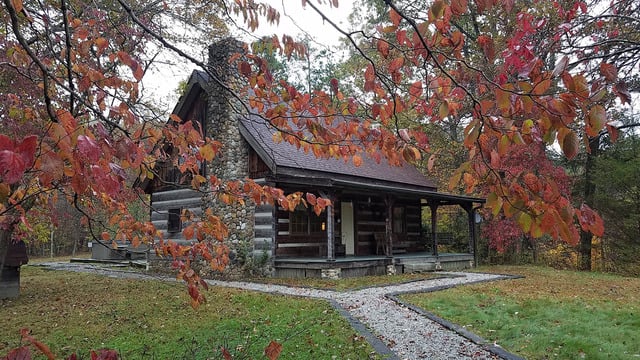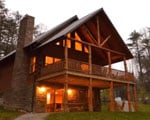JOHN BRYAN STATE PARK
John Bryan is the most scenic state park in western Ohio. The park contains a remarkable limestone gorge cut by the Little Miami River which is designated as a state and national scenic river. A portion of the gorge itself is designated as a national natural landmark.
Much of the history of John Bryan State Park is "written in the rocks" of the Little Miami River gorge. Entering the area at Clifton, at 980 feet above sea level, the Little Miami drops 130 feet through layer upon layer of bedrock. Each layer has a story to tell of times when the area was covered by warm, shallow seas or was a part of a muddy river delta or was scoured by tons of slow-moving glacial ice. Each layer has its own characteristics as well. Some of the shale layers are easily worn away by the forces of erosion, causing undercutting in the cliff face. The more erosion-resistant dolomite or limestone rocks above are weakened by this undercutting and large "slump blocks" fall away, creating unusual rock formations including Steamboat Rock. Springs feeding small waterfalls and cascades are common.
The glaciers did not only affect the land forms, they also had an effect on the vegetation found here. As the last glacier retreated and the climate warmed, the cool shaded recesses of the gorge valley provided a suitable habitat for several Canadian plant species: Canada yew, redberry elder, mountain maple, arborvitae and even a few hemlocks.
More than 100 different trees and shrubs have been identified in the park. More than 340 species of wildflowers grow wild here. Snow trillium, Virginia bluebells, bellworts, wild ginger, Dutchman's breeches, Jack-in-the-pulpit and wild columbines are only a few to be seen in the park. The dominating trees are oaks and maples, but large numbers of sycamores and cottonwoods can be found along the river. Wildlife is also abundant in the park. For instance, more than 90 different varieties of birds live in or visit the park area during the year. To fully appreciate the beauty of John Bryan, one needs to experience it during all four seasons.
Some of the first people to experience the area's beauty were the Moundbuilders, and later, the Shawnee Indians. Just five miles south of Yellow Springs, approximately where the town of Oldtown is now, was the site of Old Chillicothe, one of the leading Shawnee settlements in Ohio. The great Shawnee warrior, Tecumseh, was a frequent visitor here and to the nearby James Galloway House, which has been kept intact by the Greene County Historical Society.
This portion of the Little Miami River was a vital, economical source of power for the early settlers in the 1800s. The Cincinnati-Pittsburgh stagecoach road served the area and several enterprising settlers began establishing water-powered industries in the gorge. The town of Clifton prospered from the textile mill, grist mills and sawmills located there.
By the late 1800s, most of the industrial activity in the area ceased. Water was no longer an economical source of power and many mills were abandoned. However, one of the grist mills built in 1869 is still in operation. Located in the village of Clifton, the Clifton Mill is open to visitors.
The park takes its name from an ambitious businessman who was responsible for the preservation of much of the area as a state preserve. In 1896, Bryan purchased 335 acres along the gorge and called these acres, "Riverside Farm."
John Bryan had a great respect for the natural world. In 1918, he bequeathed Riverside Farm to the state of Ohio, "...to be cultivated by the state as a forestry, botanic and wildlife reserve park and experiment station," which would bear his name. In May of 1925, John Bryan's land became one of the state's first forest parks. In 1949, John Bryan State Park was transferred to the newly created ODNR Division of Parks and Recreation. John Bryan State Park and the adjoining Clifton Gorge State Nature Preserve overlook the beautiful Little Miami River gorge that has been designated as a National Natural Landmark by the U.S. Department of the Interior.
Ohio does not have an annual pass and does not charge entrance fees to state parks.
GeneralLand, acres752
Water, acres-12
Day-UseFishingyes
Hiking Trail, miles11
Picnickingyes
Picnic Shelters, #2
Nature Programsyes
CampingPrimitive, #50
Electric Sites, #10
Pets Permittedyes
Dumpstationyes
Group Camp, capacity100
Rent-A-Teepee, #1
WinterSleddingyes
Cross-Country Skiingyes
The family camp area at John Bryan has 100 non-electric partially shaded sites equipped with picnic tables, fire rings, latrines, drinking water and a dump station. Campers with pets are permitted on any site. A 100-person group camp area is available for organized groups on a reservation basis.
The day-use lodge is available for rentals throughout the year. The lodge is equipped with two fireplaces, restroom facilities, large screened-in porch and kitchen with stove, refrigerator and a 50-cup coffee maker.




